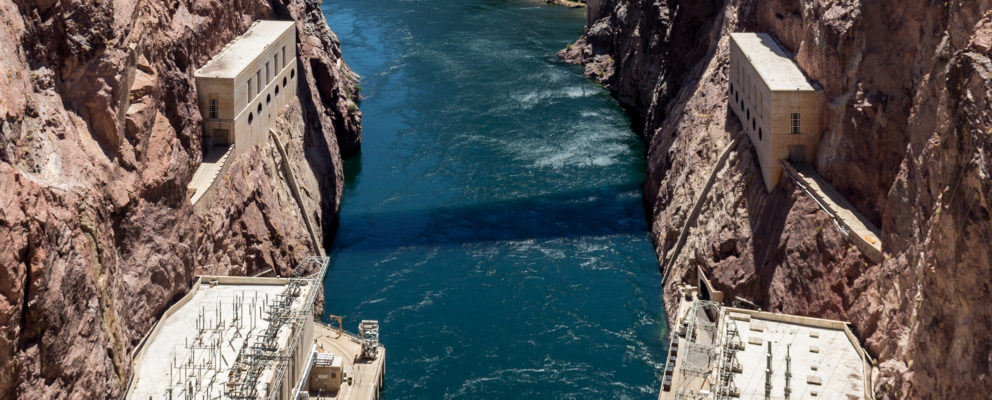CEnREP Alumni explore the interaction between water availability and electricity production decisions.
Jonathan Eyer, Postdoctoral Fellow Research Fellow at the University of Southern California,  and Casey J. Wichman, Fellow at Resources for the Future, both CEnREP alumni, recently co-authored a paper in the Journal of Environmental Economics and Management. Their paper estimates the effect of water scarcity on the US electricity fuel mix using monthly plant-level electricity generation levels over an 12-year period. The full research article, “Does water scarcity shift the electricity generation mix toward fossil fuels? Empirical evidence from the United States” is published in the Journal of Environmental Economics and Management.
and Casey J. Wichman, Fellow at Resources for the Future, both CEnREP alumni, recently co-authored a paper in the Journal of Environmental Economics and Management. Their paper estimates the effect of water scarcity on the US electricity fuel mix using monthly plant-level electricity generation levels over an 12-year period. The full research article, “Does water scarcity shift the electricity generation mix toward fossil fuels? Empirical evidence from the United States” is published in the Journal of Environmental Economics and Management.
The following post was written by Casey Wichman for Resources for the Future’s Common Resources blog.
One statistic that continues to amaze me is that the electric generation sector, overall, withdraws more water than any other sector in the United States each year—more than agriculture, more than the industrial and commercial sectors, and more than we consume as residents.
Hydroelectric generation is naturally water intensive: it uses water as a fuel. Coal, natural gas, and nuclear power generation, require a lot of water, too. Primary fuels are used to boil water, creating steam, which turns turbines with its pressure. Water is also used to cool that steam, improving the efficiency of the power plant. Even concentrated solar power plants require a lot of water and, unfortunately, they operate best in a desert, a landscape defined by its lack of the resource.
The dependence of energy systems on water leaves the open question: Is electricity generation vulnerable to increases in water scarcity? This question is particularly relevant as we expect increased frequency and severity of drought as the climate changes. Jonathan Eyer of the University of Southern California and I shed light on these issues in a new article in the Journal of Environmental Economics and Management, “Does Water Scarcity Shift the Electricity Generation Mix toward Fossil Fuels? Empirical Evidence from the United States.”
In order to estimate the effect of water scarcity on US electricity production, we use an econometric model of monthly plant-level electricity generation levels between 2001 and 2012 for each power plant in the United States. Our primary finding is that decreases in water availability decrease the generation coming from hydroelectric power plants, the largest share of renewable generation in the country. This is not a surprising result, but its magnitude is large: picking up the average plant in our sample and dropping it into moderate drought conditions would result in a 27 percent reduction in hydroelectric generation.
Additionally, we find increases in electricity generation from fuel sources that are less water intensive, particularly natural gas generation in the western United States. We also find suggestive evidence that coal generation declines slightly in favor of natural gas. This switch occurs because natural gas generation is, on average, more water-efficient than that of coal.
So, what do these effects mean? It follows that any switch from renewable (e.g., hydropower) to fossil fuel (e.g., natural gas) generation, all else equal, will increase carbon dioxide (CO2) emissions, and we estimate this effect directly at the state level. Increases in water scarcity increase CO2 emissions and that of other precursors to air pollution—sulfur dioxide and nitrogen oxides. We estimate the social costs of water scarcity in the electricity sector attributable to induced CO2 emissions alone to be $450 million per state each month (2015 dollars). That is, placing the average state in our sample in a moderate drought for one year would result in economic damages of approximately $5.4 billion. This estimate, however, excludes any other market or non-market impacts, such as the price of electricity or human health damages from air pollution.
Our results identify an important feedback at the nexus of water and energy systems: drought-induced changes to the electricity fuel mix shifts generation toward fossil fuels. Our analysis is only one piece of the puzzle. We estimate a single social cost based on observable historical trends in the US electricity sector. As climate change, population growth, and economic growth continue to place strain on energy systems worldwide, future research and policy must incorporate the interdependence between water and electricity.
